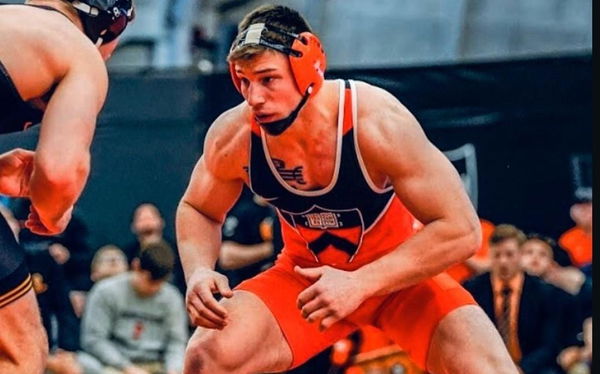

In the world of sports, wrestling might be one of the most cruel sports. Here, athletes push themselves to the max, frequently wearing themselves out in the process. They take the risks of fierce competition and aim for success with everything that they got, be it mental or physical aspect. This was the case for a long while. However, in today’s scenario, there has been a change. Wrestlers and coaches have started avoiding a few specific tournaments to reduce dangers in a sport where weary pairings are the norm. But does the real spirit of the sport and fan excitement suffer as a result of this protective stance?
The famous NCAA wrestler Patrick Brucki has expressed his thoughts on the new norm in a conversational interview with Mike Pal. He’s stating how the safeguard mindset has changed individual athletes and the overall scenario of wrestling. Diving into if this take is working? Are the wrestlers really becoming too concentrated on protecting themselves over the true essence of this sport’s ask?
ADVERTISEMENT
Article continues below this ad
Patrick Brucki’s insights on strategy over competition
The pressures of high-level wrestling are nothing new to Patrick Brucki. He’s a member of the prestigious Princeton wrestling team, with a career filled with amazing feats. At Michigan, he served as team captain, under whom they won the Big Ten title. He was a two-time NCAA All-American and a standout figure in the wrestling world. He is currently an assistant wrestling coach at Stanford University. Brucki’s success in the sport isn’t just about raw power; it’s about precision, strategy, and resilience. But it’s this very strategy that he’s been skeptical about lately, as the current trend in wrestling shifts toward protecting athletes from the physical toll of competition.
In his interview with Mike at The Athletor Podcast, Brucki uncovered that many wrestlers, including himself, have had to adapt to the changing nature of the sport. “We used to go all in, wrestling the toughest opponents in every competition,” Brucki said. “Now, there’s a strategic element that forces athletes to sit out key matches, to avoid burning out before championship season.” This shift, while protective, triggers an important question: Is this really the best approach for the sport’s long-term health?
The concerns are also valid, as are the ones Patrick Brucki raised, as fans are starting to notice the missing matchups they were excited about. “Fans show up expecting to see this matchup, and it doesn’t happen… let’s just wrestle, man. Let’s wrestle the season as it’s played out. Go chase the best competition. Don’t hold yourself out for this or for that.” This new norm is because injuries can force athletes to spend more time on recovery rather than honing their skills, for instance, AJ Ferrari skipping the Cliff Keen Invitational in Las Vegas.
This shift might make sense from the perspective of health. Noting, it also comes at the expense of the spirit of wrestling. Brucki believes that the essence of the sport lies in its competitive nature. Every match matters and every opponent should be facing their opponents head-on, but playing it safe has a deeper approach.
The Broader impact on NCAA wrestling
The shift in mindset from high-level competition to strategic self-preservation has far-reaching consequences. It not only changes the way individual athletes approach the season. But also affects fans, coaches, and the future of the sport itself. Coaches are under increasing pressure to prioritize long-term athlete health. Yet this new culture may be costing the wrestling its most exciting rivalries.
What’s your perspective on:
Has the strategic shift in wrestling robbed fans of the thrilling matchups they crave?
Have an interesting take?
Like wrestler Carter Starocci, after being defeated by Trent Hilday at Trials for the Paris Olympics 2024, took a break, making plans to return in the final season, stated, “I’m not just showing up for another season; I’m putting in work that most won’t see and even fewer will do. When you love something, you are willing to give it all for it. Instead of working overtime, I work all the time.”

ADVERTISEMENT
Article continues below this ad
Patrick Brucki’s perspective is one shared by many in the wrestling community. He explains how earlier, wrestlers like him would eagerly face off against the best, regardless of the risks. “We didn’t hold back. The grind was part of what made us tough,” Brucki recalled. Yet, as the sport has evolved, there is now a greater emphasis on managing wear and tear.
The strategic decisions that are seen as necessary for athletes to make it through an entire season. This shift has led to debates within the community about the integrity of the sport. “Fans are coming to matches expecting to see top-tier competition, but now they’re left disappointed when top wrestlers are absent,” said Brucki.
ADVERTISEMENT
Article continues below this ad
So, what’s the solution? Should wrestlers continue to prioritize their health over head-to-head battles with the sport’s elite? Brucki advocates for a return to the old days of wrestling. Where athletes competed in every match, regardless of the potential risk. “I would like to bring back the days where everybody wrestled everybody you know and it wasn’t a game of yeah we’re going to hold this guy out he’s not going to go to this big tournament…” he said.
Yet, it’s important to acknowledge that while this mindset can energize the sport, it may also increase the risk of injuries. In the end, the question remains: Is the shift toward strategic injury prevention detrimental to the spirit of NCAA wrestling? Or is it a necessary evolution for the well-being of athletes?
ADVERTISEMENT
ADVERTISEMENT
ADVERTISEMENT
ADVERTISEMENT


Has the strategic shift in wrestling robbed fans of the thrilling matchups they crave?